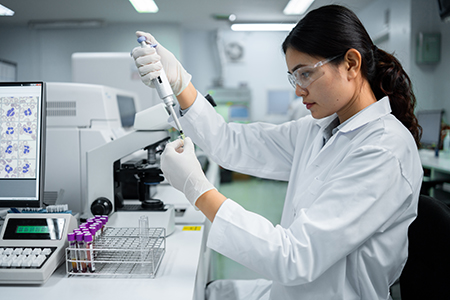Cases of STIs are on the Rise
Sexually transmitted infections are more common than you think. In fact, over 2.5 million infections were reported to the Centers for Disease Control (CDC) last year alone ¹. While the COVID-19 pandemic caused a brief decrease in the number of reported STD cases, these numbers are beginning to climb.
Because some sexually transmitted infections are becoming resistant to treatment, awareness of these common infections is more important than ever before.
What are some common STIs?

Some of the most common sexually transmitted infections (STIs), also known as sexually transmitted diseases (STDs), are gonorrhea, chlamydia, and syphilis. Other STIs include:
- HIV/AIDS
- Genital herpes
- Mycoplasma genitalium (Mgen)
- Trichomoniasis
- Human papillomavirus (HPV)
- Hepatitis
- Bacterial vaginosis (BV)
- Pubic lice
- Scabies
- Mpox
Over half of reported cases of STIs are among adolescents and young adults aged 15–24 years ². Other groups which may be more affected by STIs include gay, bisexual, and other men who have sex with men (MSM); pregnant women and infants; and racial and ethnic minorities. While some populations are more at risk than others, anyone who is sexually active can contract an STI.
Symptoms of STIs
 Symptoms of STIs can vary. Some people may have no symptoms at all and can spread the infection without even knowing it. If symptoms develop, they might include:
Symptoms of STIs can vary. Some people may have no symptoms at all and can spread the infection without even knowing it. If symptoms develop, they might include:
- Pain or burning during urination
- Unusual discharge or odor
- Itching
- Pain, swelling, or soreness
- Bleeding
- Blisters, warts, or sores
- Flu-like symptoms, including sore throat
How are STIs treated? And what happens if they aren’t?
 If you test positive for an STI, it is important to work with your healthcare provider to get the proper treatment. While not all STIs are curable, all STIs are treatable. Be sure to take all of your prescribed medication, even if you are feeling better, and avoid sexual contact until you and your partner(s) have completed treatment. Without treatment, many STIs can lead to severe consequences.
If you test positive for an STI, it is important to work with your healthcare provider to get the proper treatment. While not all STIs are curable, all STIs are treatable. Be sure to take all of your prescribed medication, even if you are feeling better, and avoid sexual contact until you and your partner(s) have completed treatment. Without treatment, many STIs can lead to severe consequences.
Some untreated infections, like syphilis, can spread to the brain and other organs. Others can make it easier for you to become infected with HIV. For some individuals, the consequence of untreated STIs might also include Pelvic Inflammatory Disease (PID), infertility, or pregnancy complications. Another consequence of untreated infections is the risk of passing the infection to others. Untreated STIs can infect babies during pregnancy and delivery.
Cases of congenital syphilis have increased 235% since 2016, making the underdiagnosis of syphilis a frightening problem for expecting parents. HNL Lab Tests Direct can be a convenient option to obtain private syphilis testing, as this test can be completed at any HNL Lab Medicine Patient Service Center. All pregnant women should undergo an STI exam to rule out the potential for congenital infections.
What can I do to prevent STIs?
Discuss sexual activity with all partners and make regular STI exams a priority. Avoid high risk sexual activities and reduce your number of partners (or practice mutual monogamy). Use protection, including condoms and other barrier methods like dental dams, and make sure any toys or objects are protected, too.
If you have certain STIs, like HIV or herpes simplex virus, taking your antiviral medications as prescribed can decrease the chance of passing the infection onto a partner. Some STIs, like HIV and hepatitis, have something called prophylaxis, which can be taken within 72 hours of exposure to reduce the risk of contracting the infection. If you think you’ve been exposed to HIV or hepatitis, contact a healthcare provider immediately. Another great way to prevent STIs is vaccination. Find out if the HPV, Mpox, or hepatitis B vaccine is right for you.

For more information
There are many options for STI testing. For example, HNL Lab Tests Direct offers testing for three major STIs (gonorrhea, chlamydia, and syphilis), which can be obtained discreetly if you have any privacy concerns. If an abnormal result is returned, patients should contact their healthcare provider for treatment.
For more information about STIs, visit the CDC’s website. If you or a partner are experiencing any symptoms of STIs, please contact your healthcare provider as soon as possible. Because some infections can be asymptomatic, it is important for all sexually active individuals to get regular screening according to CDC guidelines.
REFERENCES
¹ Centers for Disease Control and Prevention. (2022, September 01). Preliminary 2021 STD surveillance data. U.S. Department of Health and Human Services. https://www.cdc.gov/std/statistics/2021/default.htm.
² Centers for Disease Control and Prevention. (2022, April 12). Sexually transmitted disease surveillance 2020: National overview. U.S. Department of Health and Human Services. https://www.cdc.gov/std/statistics/2020/overview.htm.
³ Centers for Disease Control and Prevention. (2022, August 22). New data show that STDs remain far too high. U.S. Department of Health and Human Services. https://www.cdc.gov/std/statistics/2020/default.htm.